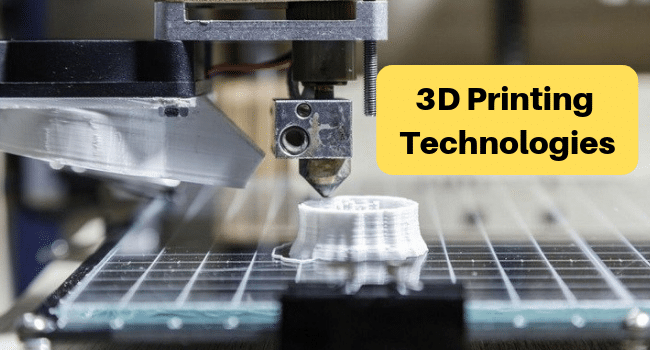Table of Contents
3D Printing Technologies: The ability to create solid three-dimensional physical objects using computer software has revolutionized manufacturing.
The mass adoption of 3D printing has afforded manufacturing and industries the ability to streamline efficiency and lower barriers to entry.
Today, there are several types of 3D printing and prototyping services available to businesses. The technology used would depend on the specific product application.
Whether you require a concept model or consumer product, there is 3D printing technology that can address your needs.
3D Printing Defined
Also referred to as additive manufacturing, 3D printing is a fabrication technique used to create solid objects.
Unlike subtractive fabrication methods, 3D printing builds solid three-dimensional objects through successive additions of thin layers.
An object is constructed by adding one thin layer at a time. Because of this fabrication technique, 3D printing is a singular production process.
3D printers can manufacture complex geometries unavailable through subtractive manufacturing.
Selecting which type of 3D printing is the right fit will be decided by three factors. The first is the requirements of the project.
The second is the chosen production material required by the final product. And the third factor is budget.
With these factors in mind, here are the three most common printing technologies currently available.
Also Read: Android Spy Software
1. Fused Deposition Modelling
Fused Deposition Modelling, or FDM, is one of the most established 3D printing methods available today. Its popularity is driven by its accessibility and affordability.
As an entry point to 3D printing, FDM is commonly found in the majority of hobbyist 3d printers.
FDM uses a 3D printing technique called extrusion. Once the production material, usually a thermoplastic filament, reaches its melting point, it is fed through the 3D printer’s head (extruder).
The printing head deposits the melted production material in a layered fashion.
Because molten material quickly solidifies, each successive layer is fused together. The layering process continues until the desired three-dimensional object is achieved.
Fused Deposition Modelling is capable of creating objects with improved durability. This printing technique is best suited for proof-of-concept models that require strenuous testing.
Other common applications of FDM include production parts and jigs and fixtures.
2. Selective Laser Sintering
Selective Laser Sintering (SLS) is a Powder Bed Fusion process used to construct 3D printed objects. SLS requires a thermal energy source such as a high-powered laser.
The laser selectively sinters a powdered material, melting and fusing the raw material to form a solid structure.
The production material sits on a print bed full of raw powdered material. After the laser sinters the powdered particles together, a roller sweeps a new coat of raw powder.
This process is repeated layer upon layer until the object is fully complete.
Production materials associated with SLS are plastic-based materials. Namely, composite thermoplastic materials such as nylon and thermoplastic polyurethane (TPU).
SLS technology is typically reserved for industrial applications and professional companies offering 3D printing and design services.
This is due to SLS 3D printers being a considerable size, and costly too. An average SLS printer will usually start at around USD $10,000.
Common applications of SLS include functional prototyping and custom manufacturing.
3. Stereolithography
Similar to Selective Laser Sintering, Stereolithography (SLA) uses a thermal energy source to produce a singular solid object.
But unlike the SLS process, SLA requires liquid photosensitive resin to form a three-dimensional object.
Like SLS, the production material for SLA sits in a resin tank. And, rather than raw powdered material, a liquid photopolymer resin is used.
SLA uses a technique called photopolymerization. Simply put, photopolymerization selectively solidifies the liquid resin via a light source.
As each layer is cured, the resin tank descends in small increments. The final 3D printed object is pulled out of the resin, layer by layer, using a bottom-up technique.
Because photopolymerization requires a photo-curable liquid resin, the production material that can be used in SLA must be resin-based. There are six categories of photopolymer resin:
- Standard
- Castable
- Transparent
- High Temperature
- Flexible
- Durable
SLA can produce a finished 3D printed object that is highly detailed with a smooth surface. SLA is ideal for products that require tight tolerances.
This makes SLA a great option for a range of industries. This can vary from dentistry and jewelry to product design and model making.
Typical applications of SLA include molds, hearing aids, jewelry (investment casting), and dental implants.
While there are large-scale industrial SLA 3D printers, hobbyists can obtain desktop SLA printers. The average price point of an SLA printer is currently approximately USD $3,500.
4. 3D Printing for the Future
While there are several other 3D printing processes available, these three printing methods represent three core categories in 3D printing.
The continued rise of 3D printing technologies means the 3D printing landscape is constantly evolving.
As the industry continues to innovate, expect to see new materials and printing processes. These emerging materials and processes will allow new industries to realize the limitless potential of 3D printing.
Nevertheless, regardless of your object’s design and function, there is already an appropriate 3D printing method available.
AUTHOR BIO
Pir Arkam is the Founder at Proto21 3D Printing LLC in the UAE.
The company is dedicated to accelerating 3D printing and additive manufacturing adoption by providing rapid prototyping services with a free consultation and delivering 3D printing training workshops. Proto21 has a solution for every phase of the product development cycle in all of the major industries.
